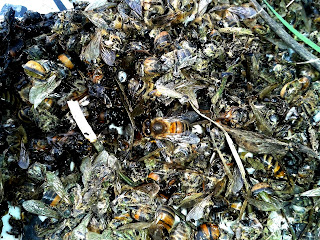Saturday morning found Field Study's Man in E17 distracted from his preparations for a series of emanations aimed at demystifying rainfall; emanations or explanations intended for five-year-olds. The distraction was our monthly stint volunteering for the Organiclea fruit and veg' stall by the Hornbeam Centre, on Baker's Avenue, E17. On the way to the stall my alter ego reported on some of it's progress in preparing the explanations. It seems that the mystified five-year-olds are not or will not be children (or even human) as I assumed, and that the field student will explain rainfall to other things which are five years old.
"Not Joseph Beuys and all that dead hare stuff again," I thought.
"How did you know?" it asked, quite surprised.
"Strangely, I happen to be able to read your mind," I replied with a yawn, as it was before 8am on a Saturday morning.
"Strangely you happen, sounds about right," it quipped.
As we cycled down Hoe St' together I tried to distract the field student further from the eccentricities of the avant garde by questioning what it means to volunteer; an intervention that included asking the question, 'when is volunteering not really volunteering?'
My ponderance was left hanging, ousted by the practical task of setting up the stall and preparing the produce for sale. The setting up was accomplished quickly as we are in, or are approaching, the 'hungry gap' - a time of the year when a predominantly local seasonally supplied stall will have less produce to prepare and sell.
One of the local items or foodstuffs available from the stall is, 'Walthamstow Honey' (2012) produced by the bees of Eric Beaumont, I believe. My sadness persists at not having managed to harvest any honey from our bees last year and I hope that my inexperience and hopefully decreasing ineptitude as an apiarist will not be as challenged this year. While I plied Walthamstow's foodies with local produce on a warming morning full of the promise of Spring, I thought ahead to the afternoon when I would visit our apiary to check on the overwintered bees and dwell on the hope and prospect of honey 2013. Just how local would it be?
Apiary 16th February 2013
all 3 hives appear active and well populated
we have been feeding the bees over winter with fondant
I'd gone to the apiary with 'Neopoll' to feed to the bees.
The bees had started foraging and could be seen returning to the hives with pollen sacs. I noticed 2 colours to the pollen sacs - a pale creamy one (above), and a brighter mustard (below). I wondered what the provenance might be for this pollen - a foodstuff which is very important at this time of year to honeybee well being.
How far do bees fly to forage for pollen and nectar? The maximum range might be 6 miles however bee colonies foraging that far will get little benefit from the forage as they will be expending more energy than they are actually getting. The less distance the bees have to fly for forage the better provided the immediate environment supplies their nutritional needs. Foraging range is also very important when it comes to considering the presence of pesticides and genetically modified crops in the environment - an issue that is perplexing many beekeepers.
I had a quick scout around the allotment for early flowering plants that may be providing bees with forage. I found a patch of Lungwort, Pulmonaria officinalis which honeybees might forage. As well as that, there were catkins which bees can use as a source of pollen although their role is not entomophilic as far as that plant is concerned.
Lungwort
The apiary and allotment is just about 3 miles from Walthamstow as the crow flies, but the latter is out of range for productive forage as far as our bees might fly.
Further to the north, some 40 odd miles away and later in a long weekend, I came across a great show of snowdrops, Galanthus nivalis, well out of range of our bees but all being well not out of range of those of other beekeepers. I hoped the bees 'back home' would be discovering similar swathes of plenty and I thought it would be a good thing to plant an area with snowdrop bulbs for next year.
Mean while, in the darker reaches of a field student's imagination, another colony of bees is settling into a new hive all a hum to the note of E.
Dead bees in the compost

































